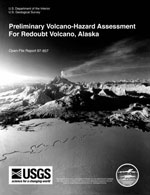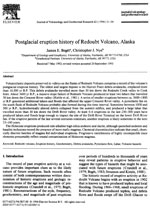Redoubt Northfork Lahars
Start: 3410 yBP ± 60 Years [1]
Stop: 1630 yBP ± 70 Years [1]
Event Type: Not an eruption
Description: From Beget and Nye (1994): "Several lahars, tephra layers, and beds of alluvium separated by peat layers and thin soils are exposed in 10-30-m-high streamcuts along the North Fork of the Crescent River. These deposits record eruptions of Redoubt Volcano that are younger than the Crescent River lahars and that strongly affected the upper parts of the Crescent River drainage. We refer to this newly recognized set of deposits as the North Fork lahars (Fig. 1 [in original text])."
"Together these laharic deposits form a flat-topped valley fill that occupies virtually the entire upper Crescent River valley. The surface gradient of the valley fill is about 0.01-0.02 near the confluence of the Lake Fork and the North Fork of the Crescent River; when traced upvalley it merges into a steeper fan with a gradient of as much as 0.2 that debouches from the central of three valleys on the southwest flank of Redoubt Volcano. This valley directly drains the summit region of Redoubt Volcano, and was apparently the primary source of the North Fork lahars, although some of the material may have come down the other valleys from the summit of Redoubt Volcano."
"Numerous exposures through the valley fill expose as many as 4-6 separate yellow to gray lahars composed primarily of fresh lithic fragments. These monolithic lahars are typically 1-3 m thick (Figs. 9, 10 [in original text]). The North Fork lahars typically have a coarse sand-sized matrix and contain many andesitic clasts 50-100 cm or more in diameter, and so are much more coarse grained than the clay-rich lahars found downstream. One thick lahar exposed for several kilometers in stream cuts near the confluence of the North Fork and Lake Fork contained numerous prismatically jointed blocks, which were apparently hot when emplaced. Some clasts in this lahar had reddish hydrothermally altered rinds, while others were surrounded by rings of reddish hydrothermal alteration in the enclosing fine-grained lahar sediment. We believe this lahar consisted in part of still-hot pyroclastic flow debris or collapsed dome rocks. The other lithic lahars exposed along the upper Crescent River probably also consist largely of reworked pyroclastic debris, although evidence of heat is only rarely encountered."
"At least three sets of deposits of younger alluvium, lahars, and tephra can be recognized above the sequence of thick lahars (Figs. 9, 10 [in original text]). The upper thin lahars also appear to be monolithologic, and contain matrix-supported clasts as much as 20-50 cm in diameter, and consist almost entirely of gray andesite. These sediments resemble deposits laid down in the lower Drift River valley during the 1966 and 1989-1990 eruptions, and may have been produced when small pyroclastic flows were emplaced over snow and glaciers. Radiocarbon dates of 2080+/-60 and 1840+/-50 yr B.P. on peat layers interbedded with the youngest lahars in the upper Crescent river valley suggest that eruptions affected the Crescent River valley for almost two thousand years after the time of the Crescent River lahars. Radiocarbon dates of 1630+/-70, 2230+/-60, 2270+/-70, 2930+/-60, 3120+/-60, 3320+/-70, 3410+/-60 yr B.P. on peat adjacent to tephra layers of fine to medium lapilli exposed in coastal bluffs 30 km east of Redoubt Volcano also show that pyroclastic eruptions continued for more than 1800-2000 years after the time of the Crescent River lahars (Table 1 [in original text]). The base of the North Fork lahar sequence is not exposed anywhere along the upper river, but the two clay-rich Crescent River lahars exposed in beach cuts 20 km downstream presumably underlie the multiple North Fork lithic lahars found nearer to the volcano."
"Together these laharic deposits form a flat-topped valley fill that occupies virtually the entire upper Crescent River valley. The surface gradient of the valley fill is about 0.01-0.02 near the confluence of the Lake Fork and the North Fork of the Crescent River; when traced upvalley it merges into a steeper fan with a gradient of as much as 0.2 that debouches from the central of three valleys on the southwest flank of Redoubt Volcano. This valley directly drains the summit region of Redoubt Volcano, and was apparently the primary source of the North Fork lahars, although some of the material may have come down the other valleys from the summit of Redoubt Volcano."
"Numerous exposures through the valley fill expose as many as 4-6 separate yellow to gray lahars composed primarily of fresh lithic fragments. These monolithic lahars are typically 1-3 m thick (Figs. 9, 10 [in original text]). The North Fork lahars typically have a coarse sand-sized matrix and contain many andesitic clasts 50-100 cm or more in diameter, and so are much more coarse grained than the clay-rich lahars found downstream. One thick lahar exposed for several kilometers in stream cuts near the confluence of the North Fork and Lake Fork contained numerous prismatically jointed blocks, which were apparently hot when emplaced. Some clasts in this lahar had reddish hydrothermally altered rinds, while others were surrounded by rings of reddish hydrothermal alteration in the enclosing fine-grained lahar sediment. We believe this lahar consisted in part of still-hot pyroclastic flow debris or collapsed dome rocks. The other lithic lahars exposed along the upper Crescent River probably also consist largely of reworked pyroclastic debris, although evidence of heat is only rarely encountered."
"At least three sets of deposits of younger alluvium, lahars, and tephra can be recognized above the sequence of thick lahars (Figs. 9, 10 [in original text]). The upper thin lahars also appear to be monolithologic, and contain matrix-supported clasts as much as 20-50 cm in diameter, and consist almost entirely of gray andesite. These sediments resemble deposits laid down in the lower Drift River valley during the 1966 and 1989-1990 eruptions, and may have been produced when small pyroclastic flows were emplaced over snow and glaciers. Radiocarbon dates of 2080+/-60 and 1840+/-50 yr B.P. on peat layers interbedded with the youngest lahars in the upper Crescent river valley suggest that eruptions affected the Crescent River valley for almost two thousand years after the time of the Crescent River lahars. Radiocarbon dates of 1630+/-70, 2230+/-60, 2270+/-70, 2930+/-60, 3120+/-60, 3320+/-70, 3410+/-60 yr B.P. on peat adjacent to tephra layers of fine to medium lapilli exposed in coastal bluffs 30 km east of Redoubt Volcano also show that pyroclastic eruptions continued for more than 1800-2000 years after the time of the Crescent River lahars (Table 1 [in original text]). The base of the North Fork lahar sequence is not exposed anywhere along the upper river, but the two clay-rich Crescent River lahars exposed in beach cuts 20 km downstream presumably underlie the multiple North Fork lithic lahars found nearer to the volcano."
References Cited
[1] Postglacial eruption history of Redoubt volcano, Alaska, 1994
Beget, J. E., and Nye, C. J., 1994, Postglacial eruption history of Redoubt volcano, Alaska: in Miller, T. P. and Chouet, B. A., (eds.), The 1989-1990 eruptions of Redoubt Volcano, Alaska, Journal of Volcanology and Geothermal Research, v. 62, n. 1, p. 31-54.[2] Preliminary volcano-hazard assessment for Redoubt Volcano, Alaska, 1997
Waythomas, C. F., Dorava, J. M., Miller, T. P., Neal, C. A., and McGimsey, R. G., 1997, Preliminary volcano-hazard assessment for Redoubt Volcano, Alaska: U.S. Geological Survey Open-File Report 97-857, 40 p., 1 plate, scale unknown.Complete Eruption References
Preliminary volcano-hazard assessment for Redoubt Volcano, Alaska, 1997
Waythomas, C. F., Dorava, J. M., Miller, T. P., Neal, C. A., and McGimsey, R. G., 1997, Preliminary volcano-hazard assessment for Redoubt Volcano, Alaska: U.S. Geological Survey Open-File Report 97-857, 40 p., 1 plate, scale unknown.

Postglacial eruption history of Redoubt volcano, Alaska, 1994
Beget, J. E., and Nye, C. J., 1994, Postglacial eruption history of Redoubt volcano, Alaska: in Miller, T. P. and Chouet, B. A., (eds.), The 1989-1990 eruptions of Redoubt Volcano, Alaska, Journal of Volcanology and Geothermal Research, v. 62, n. 1, p. 31-54.
